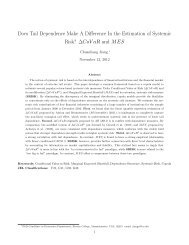Linear Algebra Notes Chapter 9 MULTIPLE EIGENVALUES AND ...
Linear Algebra Notes Chapter 9 MULTIPLE EIGENVALUES AND ...
Linear Algebra Notes Chapter 9 MULTIPLE EIGENVALUES AND ...
You also want an ePaper? Increase the reach of your titles
YUMPU automatically turns print PDFs into web optimized ePapers that Google loves.
5<br />
But also A = λI + A 0 , so<br />
λI + A 0 = A = λI + B<br />
Subtracting λI from both sides, we get<br />
[ ]<br />
0 1<br />
A 0 = B B −1 .<br />
0 0<br />
Hence<br />
because<br />
[ ] 2<br />
0 1<br />
=<br />
0 0<br />
[ ]<br />
A 2 0 1<br />
0 = B B −1 B<br />
0 0<br />
[ ] 2<br />
0 1<br />
= B B −1<br />
0 0<br />
[ ]<br />
0 0<br />
= B B −1<br />
0 0<br />
=<br />
[<br />
0 0<br />
0 0<br />
]<br />
,<br />
[ ]<br />
0 1<br />
B −1 .<br />
0 0<br />
[ ]<br />
0 1<br />
B −1<br />
0 0<br />
[ ]<br />
0 0<br />
. That was the key point. Now we have<br />
0 0<br />
A n = (λI + A 0 ) n .<br />
Inside the parentheses, we have two matrices. One of them, λI, commutes with all<br />
matrices, and the other one, A 0 , squares to zero.<br />
Now let us pause, and temporarily empty our minds of all thoughts of A and A 0 .<br />
Clear the table. On this empty table, we put two matrices [ X, ] Y with the following<br />
0 0<br />
two properties. First, XY = Y X, and second, Y 2 = . Now we add them<br />
0 0<br />
and raise to powers. The second power is<br />
(X + Y ) 2 = (X + Y )(X + Y ) = XX + XY + Y X + Y Y = X 2 + 2XY,<br />
because XY = Y X and Y 2 = 0. In the general power<br />
(X + Y ) n = (X + Y )(X + Y ) · · · (X + Y )<br />
we get each term by choosing either X or Y in each factor. Since they commute,<br />
we can put the Y ’s together, which will give zero unless we have at most one power<br />
of Y . So we either choose X in each factor (one such term), or we choose Y in one<br />
factor and X in all the others (n such terms). Thus<br />
(X + Y ) n = X n + nX n−1 Y.<br />
Now we resurrect A and A 0 , and finish our calculation: Since (λI) n = λ n I, we<br />
get<br />
A n = (λI + A 0 ) n = λ n I + nλ n−1 A 0 ,
















